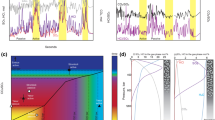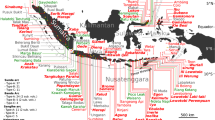Abstract
Gas bubbles form as magmas ascend in the crust and exsolve volatiles. These bubbles evolve chemically and physically as magma decompression and crystallization proceed. It is generally assumed that the gas remains in thermal equilibrium with the melt but the relationship between gas and melt redox state is debated. Here, using absorption spectroscopy, we report the composition of gases emitted from the lava lake of Kīlauea Volcano, Hawaii, and calculate equilibrium conditions for the gas emissions. Our observations span a transition between more and less vigorous-degassing regimes. They reveal a temperature range of up to 250 °C, and progressive oxidation of the gas, relative to solid rock buffers, with decreasing gas temperature. We suggest that these phenomena are the result of changing gas bubble size. We find that even for more viscous magmas, fast-rising bubbles can cool adiabatically, and lose the redox signature of their associated melts. This process can result in rapid changes in the abundances of redox-sensitive gas species. Gas composition is monitored at many volcanoes in support of hazard assessment but time averaging of observations can mask such variability arising from the dynamics of degassing. In addition, the observed redox decoupling between gas and melt calls for caution in using lava chemistry to infer the composition of associated volcanic gases.
This is a preview of subscription content, access via your institution
Access options
Access Nature and 54 other Nature Portfolio journals
Get Nature+, our best-value online-access subscription
$29.99 / 30 days
cancel any time
Subscribe to this journal
Receive 12 print issues and online access
$259.00 per year
only $21.58 per issue
Buy this article
- Purchase on Springer Link
- Instant access to full article PDF
Prices may be subject to local taxes which are calculated during checkout




Similar content being viewed by others
References
Gaillard, F., Scaillet, B. & Arndt, N. T. Atmospheric oxygenation caused by a change in volcanic degassing pressure. Nature 478, 229–232 (2011).
Simon, A. C. & Ripley, E. M. The role of magmatic sulfur in the formation of ore deposits. Rev. Mineral. Geochem. 73, 513–578 (2011).
Allard, P., Burton, M. & Muré, F. Spectroscopic evidence for a lava fountain driven by previously accumulated magmatic gas. Nature 433, 407–410 (2005).
Burton, M., Allard, P., Muré, F. & La Spina, A. Magmatic gas composition reveals the source depth of slug-driven Strombolian explosive activity. Science 317, 227–230 (2007).
Oppenheimer, C. et al. Mantle to surface degassing of alkalic magmas at Erebus volcano, Antarctica. Earth Planet. Sci. Lett. 306, 261–271 (2011).
Burgisser, A. & Scaillet, B. Redox evolution of a degassing magma rising to the surface. Nature 445, 194–197 (2007).
Moretti, R. & Papale, P. On the oxidation state and volatile behavior in multicomponent gas–melt equilibria. Chem. Geol. 213, 265–280 (2004).
Jaupart, C. & Vergniolle, S. Laboratory models of Hawaiian and Strombolian eruptions. Nature 331, 58–60 (1988).
Gerlach, T. M. Oxygen buffering of Kilauea volcanic gases and the oxygen fugacity of Kilauea basalt. Geochim. Cosmochim. Acta 57, 795–814 (1993).
Greenland, L. P. Gas analyses from the Pu’u O’o eruption in 1985, Kilauea Volcano, Hawaii. Bull. Volcanol. 48, 341–348 (1986).
Edmonds, M. et al. Magma storage, transport and degassing during the 2008–10 summit eruption at Kīlauea Volcano, Hawai’i. Geochim. Cosmochim. Acta 123, 284–301 (2013).
Edmonds, M. & Gerlach, T. M. Vapor segregation and loss in basaltic melts. Geology 35, 751–754 (2007).
Peters, N., Oppenheimer, C., Killingsworth, D. R., Frechette, J. & Kyle, P. Correlation of cycles in lava lake motion and degassing at Erebus Volcano, Antarctica. Geochem. Geophys. Geosyst. 15, 3244–3257 (2014).
Patrick, M. R., Orr, T., Swanson, D. A. & Lev, E. Shallow and deep controls on lava lake surface motion at Kīlauea Volcano. J. Volcanol. Geotherm. Res. 328, 247–261 (2016).
Gerlach, T. M. & Graeber, E. J. Volatile budget of Kilauea Volcano. Nature 313, 273–277 (1985).
Naughton, J. J., Derby, J. V. & Glover, R. B. Infrared measurements on volcanic gas and fume: Kilauea eruption, 1968. J. Geophys. Res. 74, 3273–3277 (1969).
Patrick, M. R., Anderson, K. R., Poland, M. P., Orr, T. R. & Swanson, D. A. Lava lake level as a gauge of magma reservoir pressure and eruptive hazard. Geology 43, 831–834 (2015).
Dixon, J. E., Clague, D. A. & Stolper, E. M. Degassing history of water, sulfur, and carbon in submarine lavas from Kilauea Volcano, Hawaii. J. Geol. 99, 371–394 (1991).
Clague, D. A., Moore, J. G., Dixon, J. E. & Friesen, W. B. Petrology of submarine lavas from Kilauea’s Puna Ridge, Hawaii. J. Petrol. 36, 299–349 (1995).
Dixon, J. E. & Stolper, E. M. An experimental study of water and carbon dioxide solubilities in mid-ocean ridge basaltic liquids. Part II: applications to degassing. J. Petrol. 36, 1633–1646 (1995).
Scaillet, B. & Pichavant, M. A model of sulphur solubility for hydrous mafic melts: application to the determination of magmatic fluid compositions of Italian volcanoes. Ann. Geophys. 48, 671–698 (2005).
Lesne, P., Scaillet, B., Pichavant, M., Iacono-Marziano, G. & Beny, J. M. The H2O solubility of alkali basaltic melts: an experimental study. Contrib. Mineral. Petrol. 162, 133–151 (2011).
Lesne, P., Scaillet, B., Pichavant, M. & Beny, J. M. The carbon dioxide solubility in alkali basalts: an experimental study. Contrib. Mineral. Petrol. 162, 153–168 (2011).
Holloway, J. R. Igneous fluids. Rev. Mineral. Geochem. 17, 211–233 (1987).
Alletti, M. et al. Chlorine partitioning between a basaltic melt and H2O–CO2 fluids at Mount Etna. Chem. Geol. 263, 37–50 (2009).
Moretti, R. et al. Degassing vs. eruptive styles at Mt. Etna volcano (Sicily, Italy). Part I: volatile stocking, gas fluxing, and the shift from low-energy to highly explosive basaltic eruptions. Chem. Geol. 482, 1–17 (2018).
Wright, T. L., Peck, D. L. & Shaw, H. R. in The Geophysics of the Pacific Ocean Basin and Its Margin (eds Sutton, G. H., Manghnani, M. H., Moberly, R & Mcafee, E. U.) 375–390 (American Geophysical Union, Washington DC, 1976).
Burgisser, A. et al. Backward tracking of gas chemistry measurements at Erebus Volcano. Geochem. Geophys. Geosyst. 13, Q11010 (2012).
Moussallam, Y. et al. The impact of degassing on the oxidation state of basaltic magmas: a case study of Kīlauea volcano. Earth Planet. Sci. Lett. 450, 317–325 (2016).
Elkins-Tanton, L. T. Linked magma ocean solidification and atmospheric growth for Earth and Mars. Earth Planet. Sci. Lett. 271, 181–191 (2008).
Dingwell, D. B., Courtial, P., Giordano, D. & Nichols, A. R. L. Viscosity of peridotite liquid. Earth Planet. Sci. Lett. 226, 127–138 (2004).
Li, Z. X. A. & Lee, C.-T. A. The constancy of upper mantle fO2 through time inferred from V/Sc ratios in basalts. Earth Planet. Sci. Lett. 228, 483–493 (2004).
Holland, H. D. Volcanic gases, black smokers, and the Great Oxidation Event. Geochim. Cosmochim. Acta 66, 3811–3826 (2002).
Wallace, P. & Carmichael, I. S. Sulfur in basaltic magmas. Geochim. Cosmochim. Acta 56, 1863–1874 (1992).
Oppenheimer, C. & Kyle, P. R. Probing the magma plumbing of Erebus Volcano, Antarctica, by open-path FTIR spectroscopy of gas emissions. J. Volcanol. Geotherm. Res. 177, 743–754 (2008).
Rodgers, C. D. Characterization and error analysis of profiles retrieved from remote sounding measurements. J. Geophys. Res. 95, 5587–5595 (1990).
Horrocks, L. A. et al. Open‐path Fourier transform infrared spectroscopy of SO2: an empirical error budget analysis, with implications for volcano monitoring. J. Geophys. Res. 106, 27647–27659 (2001).
Oppenheimer, C., Lomakina, A. S., Kyle, P. R., Kingsbury, N. G. & Boichu, M. Pulsatory magma supply to a phonolite lava lake. Earth Planet. Sci. Lett. 284, 392–398 (2009).
Chase, M. W. NIST-JANAF Thermochemical Tables J. Phys. Chem. Ref. Data, Monograph No. 9 (ACS, AIP, NSRDS, 1998).
Martin, R. S., Mather, T. A. & Pyle, D. M. High-temperature mixtures of magmatic and atmospheric gases. Geochem. Geophys. Geosyst. 7, Q04006 (2006).
Clift, R., Grace, J. R. & Weber, M. E. Stability of bubbles in fluidized beds. Ind. Eng. Chem. Fundam. 13, 45–51 (1974).
Figueroa-Espinoza, B. & Legendre, D. Mass or heat transfer from spheroidal gas bubbles rising through a stationary liquid. Chem. Eng. Sci. 65, 6296–6309 (2010).
Turner, J. S. Buoyancy Effects in Fluids (Cambridge Univ. Press, Cambridge, 1979).
Alberti, M., Weber, R. & Mancini, M. Re-creating Hottel’s emissivity charts for water vapor and extending them to 40 bar pressure using HITEMP-2010 data base. Combust. Flame 169, 141–153 (2016).
Acknowledgements
This work was supported by the Natural Environment Research Council (through the Centre for the Observation and Modelling of Volcanoes, Earthquakes and Tectonics and grant NE/N009312/1) and LabEx VOLTAIRE (ANR-10-LABX-100-01). Y.M. received additional support from the Leverhulme Trust. We thank P. Kelly (US Geological Survey) for his review of the pre-submission manuscript. We are grateful to V. Tsanev for discussion on gas radiation at high temperature and pressure.
Author information
Authors and Affiliations
Contributions
All authors contributed to preparation and revision of the manuscript. C.O. analysed and modelled spectroscopic data; B.S. modelled the melt-inclusion data; A.W. and C.O. developed the bubble-cooling model; A.J.S. and T.E. led the field campaign; and Y.M. contributed wider context on melt redox evolution.
Corresponding author
Ethics declarations
Competing interests
The authors declare no competing interests.
Additional information
Publisher’s note: Springer Nature remains neutral with regard to jurisdictional claims in published maps and institutional affiliations.
Supplementary information
Supplementary Information
Supplementary Figures
Rights and permissions
About this article
Cite this article
Oppenheimer, C., Scaillet, B., Woods, A. et al. Influence of eruptive style on volcanic gas emission chemistry and temperature. Nature Geosci 11, 678–681 (2018). https://doi.org/10.1038/s41561-018-0194-5
Received:
Accepted:
Published:
Issue Date:
DOI: https://doi.org/10.1038/s41561-018-0194-5
This article is cited by
-
Redox state of magma recorded in volcanic glass from an ash-forming eruption at Bromo volcano, Indonesia: Insights into the degassing process
Bulletin of Volcanology (2023)
-
Brittle fragmentation by rapid gas separation in a Hawaiian fountain
Nature Geoscience (2021)
-
Volatile metal emissions from volcanic degassing and lava–seawater interactions at Kīlauea Volcano, Hawai’i
Communications Earth & Environment (2021)
-
Rapid metal pollutant deposition from the volcanic plume of Kīlauea, Hawai’i
Communications Earth & Environment (2021)
-
Mantle data imply a decline of oxidizable volcanic gases could have triggered the Great Oxidation
Nature Communications (2020)



